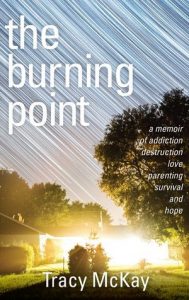 Michael Austin is a board member of BCC Press.
Michael Austin is a board member of BCC Press.
Last week, Tracy McKay published a remarkable memoir entitled The Burning Point: A Memoir of Addiction, Destruction, Love, Parenting, Survival, and Hope. I think it is a game changer. Full disclosure: I was one of the main editors of By Common Consent Press on this project. Even fuller disclosure: I became one of the main editors for this book because, the second I heard about it, I knew that it would be a game changer. Here’s why.
In the first place, The Burning Point is a beautifully written memoir. Those who have followed Tracy on her own blog, Dandelion Mama or as a regular contributor to BCC, know that she is a graceful, lyrical writer with a profound moral depth and a varied body of experience. It is a good book.
But it is also an important book. For one thing, it deals head on with the problem of opioid addiction, which was at the root of the family crisis that Tracy narrates. As this becomes a major epidemic in the United States–and make no mistake about it, it is becoming a major epidemic in the United States–books like Tracy’s will become a more and more important part of the solution.
It is also a book about being a “welfare mother,” another phenomenon that is increasingly important to our public discourse. And it tells the story of a woman returning to school to get an education–and of the important and supportive role that the LDS community played in the lives of a family of fairly recent converts to the Church. And, finally, it is a story in which the Mormon Internet Community itself plays an important part, as Tracy was only able to complete school through a scholarship created by the Feminist Mormon Housewives blog.
As I said, I think that this book can be a game changer. And, if it is, it will join a long and distinguished tradition of Mormon women’s memoirs that have changed the way that Latter-day Saints and the rest of the world interact. I can think of no category of Mormon writing in the past 50 years that has been as influential in shaping the national and international conversation about the LDS Church. Here are a few examples:
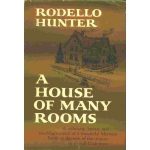 House of Many Rooms, by Rodello Hunter (1965): This quiet, simple memoir of growing up in Utah at the turn of the 19th century was an unlikely bestseller. But it was a bestseller for Knopf in 1965 and introduced a generation of readers to Mormonism in a way that sharply diverged from both the fictional (mainly Western) and nonfictional (mainly exposé) faire of the 1960s. It made Mormons seem friendly, loving, and kind of cuddly instead of scary and threatening.
House of Many Rooms, by Rodello Hunter (1965): This quiet, simple memoir of growing up in Utah at the turn of the 19th century was an unlikely bestseller. But it was a bestseller for Knopf in 1965 and introduced a generation of readers to Mormonism in a way that sharply diverged from both the fictional (mainly Western) and nonfictional (mainly exposé) faire of the 1960s. It made Mormons seem friendly, loving, and kind of cuddly instead of scary and threatening.
Goodbye, I Love You, by Carol Lynn Pearson (1986): Carol Lynn Pearson was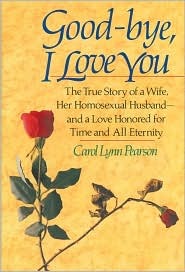 already an established writer in the Mormon market when she wrote this book about her ex husband, who had left her to pursue relationships with men, returning to her home after being diagnosed with AIDS. At a time when AIDS was still unfamiliar to most people, Pearson’s memoir highlighted the folly of telling gay men that they should marry women to “become heterosexual.” And it advocated for a more compassionate and nuanced LDS understanding of same sex attraction long before this became a major issue in the Church.
already an established writer in the Mormon market when she wrote this book about her ex husband, who had left her to pursue relationships with men, returning to her home after being diagnosed with AIDS. At a time when AIDS was still unfamiliar to most people, Pearson’s memoir highlighted the folly of telling gay men that they should marry women to “become heterosexual.” And it advocated for a more compassionate and nuanced LDS understanding of same sex attraction long before this became a major issue in the Church.
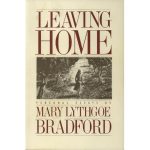 Leaving Home, by Mary Bradford (1987): Published in 1987, Leaving Home collected the personal essays that Bradford had contributed to Dialogue since the mid-1960s. These essays, like the book itself, largely created the genre of the Mormon personal essay, of which Bradford’s work is both the best example and the foundational canon. These essays did more than just about anything I can think of to give Mormon women a voice by giving them a set of tools for self-expression that was firmly rooted in Mormon history and practice, but also subtly subversive in its implications for how Mormon women would learn to shape their own narratives in ways not previously possible.
Leaving Home, by Mary Bradford (1987): Published in 1987, Leaving Home collected the personal essays that Bradford had contributed to Dialogue since the mid-1960s. These essays, like the book itself, largely created the genre of the Mormon personal essay, of which Bradford’s work is both the best example and the foundational canon. These essays did more than just about anything I can think of to give Mormon women a voice by giving them a set of tools for self-expression that was firmly rooted in Mormon history and practice, but also subtly subversive in its implications for how Mormon women would learn to shape their own narratives in ways not previously possible.
Refuge: An Unnatural History of Family and Place, by Terry Tempest Williams (1991): In my own teaching career at one public and two private universities, Refuge is the only Mormon-themed book that I 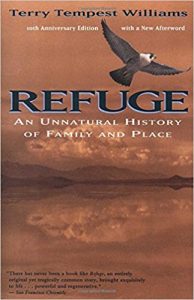 have taught and seen my colleagues teach, as an undergraduate literature text. This remarkable book weaves together two narrative strands—the flooding of the Bear River Migratory Bird Refuge and the death of Terry’s mother from cancer—to create a compelling story of wholeness, family, place, and community. From an academic perspective, it is one of the most significant works of Mormon literature ever published. And it has also touched the lives of thousands of people confronting the deaths of their loved ones.
have taught and seen my colleagues teach, as an undergraduate literature text. This remarkable book weaves together two narrative strands—the flooding of the Bear River Migratory Bird Refuge and the death of Terry’s mother from cancer—to create a compelling story of wholeness, family, place, and community. From an academic perspective, it is one of the most significant works of Mormon literature ever published. And it has also touched the lives of thousands of people confronting the deaths of their loved ones.
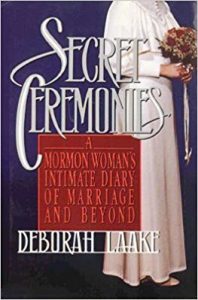 Secret Ceremonies, by Deborah Laake (1993): “How I left the Mormon Church” memoirs are a substantial subcategory of Mormon Women’s memoirs, including such classics as Ann Eliza Young’s Wife No. 19, Sonja Johnson’s From Housewife to Heretic, AND Martha Beck’s Leaving the Saints. In all of these, though, Laake’s stands out as 1) a major (and somewhat unexpected) bestseller that became something of a media phenomenon; and 2) a book that discussed Mormon temple worship in ways that no bestseller ever had before. Predictably, it combined with a resurgence of Mormon-themed genre fiction in the early 1990s—mainly mystery novels and true-crime books—to make Mormons seem weirder than they had for years.
Secret Ceremonies, by Deborah Laake (1993): “How I left the Mormon Church” memoirs are a substantial subcategory of Mormon Women’s memoirs, including such classics as Ann Eliza Young’s Wife No. 19, Sonja Johnson’s From Housewife to Heretic, AND Martha Beck’s Leaving the Saints. In all of these, though, Laake’s stands out as 1) a major (and somewhat unexpected) bestseller that became something of a media phenomenon; and 2) a book that discussed Mormon temple worship in ways that no bestseller ever had before. Predictably, it combined with a resurgence of Mormon-themed genre fiction in the early 1990s—mainly mystery novels and true-crime books—to make Mormons seem weirder than they had for years.
Embraced by the Light, by Betty Eadie (1994): This near-death-experience book explicitly Mormon book. It does not mention Momronism per se in the text. But it was marketed in Utah with an insert telling 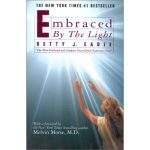 readers that Eadie was, in fact, a Mormon and that she confirmed many elements of her faith in her brief glimpse of the afterlife. And a small book publisher, Aspen Books, first published the book. Millions of people—including lots of Mormons—bought and read the book, making it a runaway bestseller. But the real influence that it had on Mormon letters was in the way that it propelled Aspen Books into the spotlight and allowed them to play a major role in the modest renaissance of Mormon literature that occurred during the 1990s.
readers that Eadie was, in fact, a Mormon and that she confirmed many elements of her faith in her brief glimpse of the afterlife. And a small book publisher, Aspen Books, first published the book. Millions of people—including lots of Mormons—bought and read the book, making it a runaway bestseller. But the real influence that it had on Mormon letters was in the way that it propelled Aspen Books into the spotlight and allowed them to play a major role in the modest renaissance of Mormon literature that occurred during the 1990s.
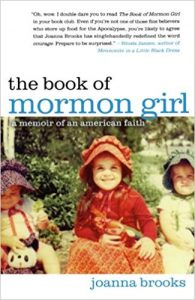 Book of Mormon Girl, by Joanna Brooks (2012): When it was first published, Book of Mormon Girl was something radically new and important: a memoir by a smart, accomplished Mormon woman who was absolutely committed to her faith but unwilling to allow anybody else to define that faith for her. This provided a model for many people to break through the “in-or-out” dichotomy that had always constrained their relationship to Mormonism and construct a variety of third-way positions that honored and cherished Mormonism but insisted on having a say in the definition of their own faith.
Book of Mormon Girl, by Joanna Brooks (2012): When it was first published, Book of Mormon Girl was something radically new and important: a memoir by a smart, accomplished Mormon woman who was absolutely committed to her faith but unwilling to allow anybody else to define that faith for her. This provided a model for many people to break through the “in-or-out” dichotomy that had always constrained their relationship to Mormonism and construct a variety of third-way positions that honored and cherished Mormonism but insisted on having a say in the definition of their own faith.
I could go on and on and on. There are thousands of books in the category of Mormon Women’s Memoir, and, perhaps more than any other kind of Mormon Literature, these books have had an enormous influence on the ways that people inside and outside of the Church understand our faith. It is this important and influential tradition that Tracy McKay has now become an integral part of, and I can’t think of a better place for a writer to be.

We were driving through Heber one day a long time ago and my mother said, “That’s the house of many rooms,” and told me about the book. I checked it out of the Farrer Jr. High library and read it, but something suggested to me that it was fiction. I think it was comparing the author’s bio dates with the dates in the story. Born in 1920, Rodello Hunter was too young for the first-person narrator to be her. I called her one time to get a bio for something we published in Irreantum. She told me she was suing the Church for violating the contract in a dramatic adaptation of House of Many Rooms. “The Church’s lawyers lie and delay,” she said.
Checking her obituary in the Deseret News for Aug. 28, 2005 I find that her father was killed in a mine accident two months before her birth, and his parents adopted and raised her in Heber, so House of Many Rooms is likely their story. I wonder if it is oral history, or her putting together of stories she grew up hearing.
And regarding oral history,,Marilyn Brown told me she wrote every word of Florence Child Brown’s I Cannot Tell a Life. I don’t know if she meant she wrote in her mother-in-law’s voice, or if she took recorded oral history interviews and edited them into a chronological narrative. If she did the former, it bespeaks a remarkable talent to take up a voice very different from that in her novels. It should be a memoir that changed the conversation, but Florence’s children were not pleased with her candor and threatened to sue her, so Marilyn withdrew it for a while, but I see it available on Marilyn’s website now.
I mentioned Good-bye, I Love You to the director of my thesis at the U of There-is-no-r-in-Warshington, and she said she’d have to read it, it sounded like her situation. But it can be hard to explain Carol Lynn Pearson’s place in Mormon culture to non-Mormons. I tried to explain in a class presentation how difficult it is to place her, but the prof had squeezed me in at the end of the hour and I didn’t have time to make a proper presentation. “Because she’s a woman [in a patriarchal society]?” someone asked. No. Because for a whole generation Carol Lynn Pearson was Mormon Poetry, but the people who thought of her as a good poet probably didn’t see her poetry as feminist, and the people who responded to her feminism were not likely to see her poetry as very good.
“You’re so cerebral, Blossom,” Gerald says at one point, but it was the more cerebral members of her audience who weren’t likely to see her as a serious writer. Richard Cracroft told a story one year at AML about how seriously she takes her writing. He said he thought she was spending too much time at her writing so he called her as stake Leaf-a-ciety president (sorry I can’t find a link to the anecdote in The Ensign about the kids playing in the leaves)–unless he was her bishop at the time. I’ve never been certain whether he was joking about the reason for the calling, but he went to visit her one day and she was writing away while another woman watched her children. She had made it a Relief Society calling to watch the president’s children for a few hours so she could write.
I did a paper a few years ago at AML about Good-bye, I Love You, Phyllis Barber’s Raw Edges, and Florence Child Brown’s I Cannot Tell a Life as narratives about troubled Mormon marriages. One woman in the audience told me there are a lot of people who think Pearson went off the deep end with this book and the work that followed.
It was interesting to me to compare Pearson with the other two. Barber is intense and harrowing, and very literary. Brown is conversational and relates some harrowing experiences in a straightforward way, but I can only think of two passages where she describes her mental state at the time of the events–when she says she was happy to learn her ex-husband (who had tried to kill her) was dead, and when she talks about going to see her son at work and finding a large pornographic poster on his office door with the words “My mother” scrawled on it. Pearson describes her interior state a lot, but is less intense than Barber in letting us feel her emotions at the time, or in asking us to share her emotions. I feel she’s holding back, shielding us from the full brunt of some very difficult feelings.
Dennis Clark makes a similar comment in his review of A Widening View (Dialogue 17:4, 151-2). He says most of the poems talk down to the audience, not across, and quotes as exceptions “The Prophet’s Feast” and “Getting Ready,” which are witty and intelligent and ask for wit and intelligence from the readers. I had heard Pearson read “The Prophet’s Feast” at a BYU Women’s conference, but it was called “Joseph’s Feast.” Reading the review I wondered if changing the title wasn’t a way of talking down to her audience, of not trusting them to get the allusion. (When Harvest came out I was interested to see if Dennis had chosen those poems, but it was “Millie’s Mother’s Red Dress” instead.)
I like Pearson’s poems a lot better when she reads them than when I hear them read over the pulpit as if they were doctrinal expositions or homilies. When she reads she sounds a lot more like Ogden Nash than Eliza R. Snow or Emmeline Grangerford, the poet in Huckleberry Finn who “didn’t ever have to stop to think” as she slapped down her lines of poetry.
Pearson came to speak at a Puget Sound regional single adult conference and at the end of her talk she took requests. I couldn’t remember the title so I asked her to read the one about the man who wouldn’t touch his wife, and she read “Getting Ready.” The satire is quite sharp,
but there’s more behind the poem than the satire. In Good-bye, I Love You she mentions a gay man she knew who just couldn’t bring himself to touch his wife.